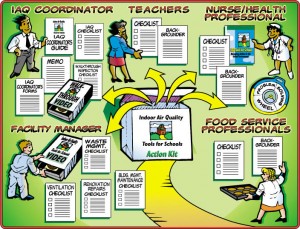Introducción del documento publicado por la Environmental Protection Agency:
Understanding the importance of good indoor air quality (IAQ) in schools is the backbone of developing an effective IAQ program. Poor IAQ can lead to a large variety of health problems and potentially affect comfort, concentration, and staff/ student performance. In recognition of tight school budgets, this guidance is designed to present practical and often low-cost actions you can take to identify and address existing or potential air quality problems. You can accomplish this using current school staff to perform a limited and well-defined set of basic operations and maintenance activities. However, some actions may require specialized expertise.
Sections 1 and 2 of this Guide help schools understand how IAQ problems develop, the importance of good IAQ, and its impact on students, staff, and building occupants. Communicating this important information with students, staff, parents, and the community is the next step, which is outlined in Section 3. Schools dealing with an IAQ crisis will find the section on communication particularly helpful. Sections 4 to 6 contain valuable information for schools that need assistance diagnosing and responding to IAQ problems with inexpensive, practical solutions.
Refer to the appendices of this Guide for detailed information on IAQ-related topics including mold, radon, secondhand smoke, asthma, and portable classrooms. Schools may find the explanations of integrated pest management programs, typical indoor air pollutants, and pollutants from motor vehicles and equipment helpful while developing school policies or pinpointing sources of poor IAQ. In addition, schools investigating or resolving IAQ problems may want to refer to appendices on basic measurement equipment, hiring professional assistance, and codes and regulations. There are numerous resources available to schools through EPA and other organizations, many of which are listed in Appendix L. Use the information in this Guide to create the best possible learning environment for students and maintain a comfortable, healthy building for school occupants.
Descargar el documento completo (PDF).

